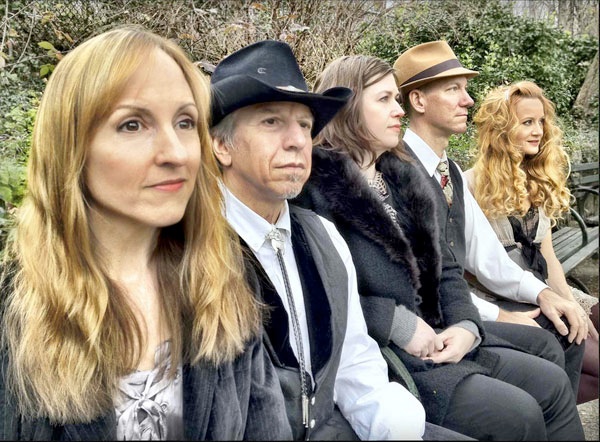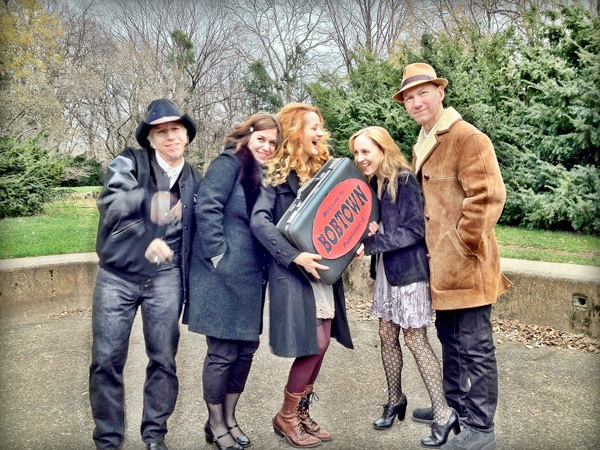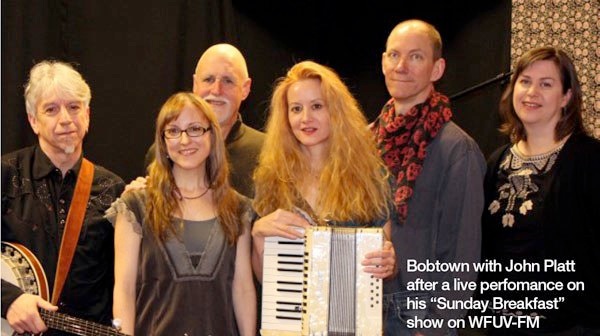Bobtown
Say Hello, America
This Band Has Arrived
By Richard Cuccaro
Photo: Farzana Razak
Bobtown, the band, is named after an outcropping of blue-collar homes located along the banks of the Des Moines River in Fort Dodge, Iowa. Without knowing this, it’s still apparent that the band’s music taps deep into the roots of the American heartland. I’m reminded of the late Chris Whitley’s song, “Dust Radio.” As the song fades out, we hear the fiddling of a dial on an old radio and a high whining static. A ghost-like broadcast of an ancient gospel program floats in on the ether from decades earlier. We hear part of a sermon about David and Goliath: “…David was a young man …” that fades out on a gospel singer’s soaring voice.
All that’s missing in Bobtown’s two albums is the static. Their sound has all the earmarks of a revival meeting rave-up sometime in the ’30s, with a muscular intensity and an exalting lift. The lead track of their latest album, Trouble I Wrought, “Mama’s Got the Backbeat,” gives me chills as they repeat the chorus of Mama’s got the backbeat, praise the lord. Handclaps and slide guitar accompany the five-part harmony. The ladies of the choir — Katherine Etzel, Karen Dahlstrom and Jen McDearman — hold down the rhythm guitar, drums and percussion while the choir’s baritones — Alan Lee Backer and Fred Stesney — are every bit the holy rollin’ rocker guitarists on electric guitar, bass and banjo.
Meet the Band

Katherine Etzel, as the originator of Bobtown, provided the source of the band’s name. She was born and raised in Fort Dodge, Iowa, and lived on a rural route across the Des Moines River from Bobtown. “I left home at 17 and left Iowa at 18,” she said.
She counts TV theme songs and commercial jingles as her earliest musical influences. There was a piano on which her mom and dad played the same three songs, over and over. A parental push for lessons went unheeded, and after they divorced there was no money. She now regrets not taking lessons. She had three brothers and a sister, about a year apart in age. Their dad, a traveling toy salesman, liked big-band music, show tunes and jazz standards and used to make cassette tapes of his favorite songs to play on the road. The kids would sing along to “I’ve Got a Love-a-ly Bunch of Coconuts” with him, barreling down two-lane highways in rural Iowa. Her mom’s tastes evolved and shifted from the West Side Story soundtrack to Janis Ian and then moving on to “other hippies,” as her dad called them.
Third of the five children, Katherine would coax her younger siblings, who also loved music, into singing pop songs with her. She started “arranging” parts for them by the time she was 9 or 10. Katherine’s aunt had a big influence on her musically from an early age until her teens. Aunt Karen had a record player and stacks of 45s. They would entertain themselves for hours in Karen’s room.
Katherine adored choir. It was where she first learned warm-ups and vocal exercises. She was in the alto section and got a taste of harmonic arranging.
Leaving Iowa for Florida while in her teens, Katherine had a number of crazy experiences immediately before she turned to music -- ranging from living in her car, to selling hot dogs in a bikini along the highway, to working the concession stand at a porn theater and caring for a crack-addicted, vodka-swilling, broken-hearted rich woman who used to whisk her away for spontaneous trips to Jamaica. She was working as a waitress in a cocktail bar when she met two nerdy musicians who needed someone to do a dummy vocal track in the studio. They were recording but didn’t have a lead singer yet. Katherine recorded the track for them and they asked her to join the band. She was about 19 and this was her first official band. Their first show was at a festival in Miami for about 2,000 people. They did a short original set (Katherine had begun writing songs), then acted as the backing band for some old-time rock acts (Freddie Cannon, Del Shannon, The Shirelles and Bo Diddley).
She next sang in a cover band in a touristy bar in Fort Lauderdale, playing there six nights a week for several years. While in the cover band, she formed an all-female rock band called Aries. They performed her rock compositions on Katherine’s one night off. Aries played a festival with the Mavericks and Marilyn Manson and appeared on Star Search in 1991, but lost. Failing to get a record deal, Katherine moved to L.A., where, after a touring gig, she pretty much stopped performing and writing entirely for several years. She focused on doing studio work and holding down a corporate job. One studio client was a country music arranger/writer who initiated her slant back toward roots music. After marrying in 2003, she moved to New York City and immediately got back into performing. She answered an ad on Craigslist for a honky-tonk band, Sweet William, where she met Fred Stesney and had a great time getting acquainted with the Brooklyn country music scene.
She left Sweet William around 2007 and became fascinated with the recordings of Alan Lomax and a song form known as field hollers, having worked in the cornfields in Iowa herself. Penning a few hollers of her own, Katherine next decided to put some singers together to perform them, eventually calling on her ex-Sweet William band mate Fred Stesney and relying on Craigslist to fill out the rest of the roster. After doing a few stripped-down, mostly a cappella shows, the group decided to incorporate more variety in songwriting and instrumentation. Everyone began contributing material and some members picked up new instruments to play. “Bobtown was a slow boil over three years before we finally began to hit our stride,” Katherine said. “Even now we pride ourselves on our ability to continually evolve.”
Her long-range goal? “To connect, always, to connect. Whether you bring a tear or a giggle, you need to connect to do that.”

Alan Lee Backer was born in Brooklyn, N.Y., and has lived in New York City his whole life. The elements for a life as a performer were in place early on. He’d hear his mom sing around the house every day. She had appeared on the legendary Major Bowes Amateur Hour when she was a child.
He got his earliest musical influence from pop singers in his parents’ record collection, like Johnny Mathis and Ray Charles. Later, it was from British invasion bands and Motown during grade school; San Francisco bands, The Byrds, Cream and Jimi Hendrix in high school and California singer-songwriters and The Grateful Dead in college.
The spark that lit his musical fire was seeing the Beatles on the Ed Sullivan Show. “It looked like a good job to have,” Alan said. After taking piano lessons, at age 13, he asked for guitar lessons and studied for a few years.
Alan played double bass in the orchestra in high school along with “sing” shows, and outside of school, starting at age 16, played guitar in a number of bands. He played for all kinds of parties, including sweet 16s. The bar gigs started in college. When he first visited Nashville in the ’90s, he was allowed to play at an open mic night at the Bluebird Cafe. “Talk about getting thrown into the deep end!” he exclaimed.
The professional influences read like a concert-goer’s fantasy: “Since I live in New York, I’ve had the opportunity to see close-up, most of the great rock ’n’ roll bands and singers — people like Bruce Springsteen, Elvis Costello, Television, the Ramones and Billy Joel — in small clubs like the defunct Bottom Line. Seeing The Band, the Dead, Santana, the Black Crowes and Jimi Hendrix in small theaters has helped me to understand how to work a crowd, construct a well-paced set and focus my energy where it’s needed.”
During the mid ’90s, he was involved with Diesel Only Records. The compilations of country-tinged bands that came out on that label (including the Twanglers, a band Alan co-founded) eventually led to publishing of No Depression magazine, which helped kick-start the alt-country /Americana movement. This association led to his song “Two Hearts (Tender, Lovin’ and True)” being featured in the movie “Freeway,” starring Reese Witherspoon and Keifer Sutherland. “Trust me, those royalty checks for ‘Freeway’ always help to turn a bad week into a tolerable one,” he said.
These days he doesn’t have to look any further than the frets of an instrument for inspiration. “Sometimes I don’t feel comfortable unless I have a guitar (or lately a banjo) in my hands. Playing helps me tune in to a higher power.”

Jen McDearman was born and raised in Memphis, Tenn. Her family’s interests plus school choir and an enthusiasm for musical theater sparked her early musical direction. At home, there was almost always music being listened to or being played. Jen said, “All of us — my sister, two brothers and I — were involved in music in some fashion, but I’m the only one who made it a habit. As the baby of the family, guess I assumed that I could get away with it.” Her parents have always adored music, and her father has a beautiful voice — harmonies come naturally to him. She’s grateful that they have passed along those interests. Jen’s grandmother, Margaret, her dad’s mother, was another major musical influence. She had played piano for silent movies in Memphis, and even worked for W.C. Handy. Jen’s parents’ album collection spanned a pretty wide range, from big band and jazz to a great collection of The Beatles’ best. To this collection, Jen added Sesame Street and Harry Nilsson, another major influence. To this day, she loves Nilsson. Later, Jen plucked The Grateful Dead, Supertramp and Kraftwerk from her siblings’ album collections. Additionally, her continued interest in musical theater drew her to The Sound of Music and other family shows.
College is where she discovered Joni Mitchell and other folk-oriented artists, and she said it changed her life. She also fell in love with XTC, Edie Brickell and others in the pop-rock world, plus lots of indie bands popular with college students.
Jen performed in a couple of cover bands in college and played a bit at dorm parties and the campus coffee house. In her early 20s, she moved to Austin to sing with a college friend in his band, Sunkats, a five-member, pop-driven group with lots of guy/girl harmonies. For the next couple of years they got some great gigs, including a regular stint at the Black Cat on Sixth Street, but ultimately went their separate ways.
Jen moved back to Memphis, did some theater and shifted to the corporate world of TV news, marketing and advertising.
For the next few years she worked in Seattle and San Francisco, where she continued to do theater more than other music. She filled in a bit for the Bootcuts Band, “a fantastic swing/country band with lots of great harmonies and humor.” This was a standout experience that renewed her interest in the country and folk styles.
While in San Francisco, she got into copywriting, and when her ad agency had an opening in New York, she took it and continued performing music as well. One favorite memory is her first music gig in New York City — at CBGB, months before it closed down. After a few forays into cover bands and other groups, she found Bobtown, and vice versa. Her goals are to just keep songwriting as much as possible and not be afraid of failing, and in performing, to be as honest as possible in every moment.
Karen Dahlstrom was born in Eugene, Ore., and grew up in Boise, Idaho. She was surrounded by music growing up. “We sang in church and in school, and there was always some kind of music playing in the house. I could carry a tune from a young age, and was encouraged by my teachers to sing,” she said.
Her mother played a little piano, while her father was a music appreciator more than a musician. They absolutely loved Willie Nelson. “Stardust” was in regular rotation in their home. Other music played often included early Elton John, Bach and show tunes. Karen didn’t sing for her parents until she was in her teens. “They’re still a bit surprised at the sound of my singing voice,” she told me. Karen has two sisters, both much older than her, and they both can sing but don’t pursue it professionally.
Karen had voice lessons intermittently when she was younger, and taught herself to play the piano. She started guitar lessons at age 30 and now also plays upright bass, banjo and mandolin.
In grade school she listened to whatever was on the radio late at night — things like top 40 and Dr. Demento. In junior high and throughout high school she sang in jazz groups and listened to a lot of jazz, particularly Ella Fitzgerald, Sarah Vaughan, Chet Baker, Bill Evans and Miles Davis. From the time she was 12, she was singing regularly at school in music classes, chorus, assemblies, plays and concerts. She also sang in bands during high school, and “we played bars before we could drink.”
Karen was a singer in vocal groups, jazz combos and big bands until she was 22, then took a break for about 10 years. Since then she’s been singing and playing with old-time and bluegrass players. This eventually led to Bobtown, which in turn eventually led to writing and playing her own songs. Karen cited Gillian Welch’s songwriting as having inspired her the most. She aspires to write and to sing in a way that is honest, that represents who she is, yet connects with people.
Fred Stesney was born and raised in the San Fernando Valley of California. His father had a collection of folk records — sea shanties and ethnic music. However, Fred listened mostly to top-40 radio. When he was in first grade, he heard Led Zeppelin’s “Immigrant Song” and “it changed my life,” he said. “That was the kind of music I wanted to listen to.” When Fred was in sixth grade, his mother had an idea for a family musical group. She had Fred take cello lessons. Her idea was that she’d play piano, Fred would play cello and his brother would play violin. “The Stesney Family Trio never materialized,” he said. His junior high school had a strong music program and he played in the orchestra, but his high school had no music program, so he gave up playing.
Fred didn’t play in a band until the early ’90s. At a party, he was approached with a concept for a lounge/punk band. As a fan of the genre, the idea agreed with him, so he became the singer because he didn’t know how to play an instrument. A few months later, the band, Black Velvet Flag, debuted at the Mercury Lounge in New York City. They caught the twin waves of the punk revival and the lounge craze and rode them both to minor success. When things sputtered out a few years later, Fred decided to pick up the bass and stumbled into Sweet William, a honky-tonk band. He realized country was a musical style where he could age gracefully. Fred admires the playing of James Jamerson and John Paul Jones, but said his style is more like Donald “Duck” Dunn and Adam Clayton.
Fred’s stated goal as a songwriter and performer is to have an impact on the listener. He fantasizes “playing an outdoor festival, singing one of my songs to a sea of people, and when I look down at the front row there’s a woman wearing a confederate flag halter top singing along.” However, backtracking nicely, he said he draws inspiration from his wife. “She’s always there for me.”
The Multi-Talent Approach

Website: bobtownmusic.com
Upcoming performances include:
Sep 15 3pm First Acoustics, Brooklyn, NY
Sep 21 7pm The Flying Cat, Phoenicia, NY
Oct 17 7:30pm Music on 4, NYC
Nov 9 NERFA Conference, Kerhonksen, NY, numerous
showcases including Acoustic Live, Sat Late (1am)
Nov 30 7pm Six on the Square, Oxford, NY
The band shows its sense of humor in this series of photos taken in an old photo booth.


